I am making a collage app for that I will be using multiple grid layouts.I am using UICollectionViewCompositionalLayout to create grids. One of my grids requires a heart shaped cell in between. Following is my code the HeartShaped item needs to be heartShape I've no idea how to do it at first I thought of using UIBeizerPath but item is not type of layer and if somehow I manage to do it inside cellForItem still I've many more grids coming and I will have to use "if" "else" again and again. Another problem I am facing my last group i.e the bottom group is not displaying.
Any help would be really appreciated.
let topItem = NSCollectionLayoutItem(layoutSize: NSCollectionLayoutSize(widthDimension: .fractionalWidth(1/3), heightDimension: .fractionalHeight(1)))
// top items group
let topGroup = NSCollectionLayoutGroup.horizontal(layoutSize: NSCollectionLayoutSize(widthDimension: .fractionalWidth(1.0), heightDimension: .fractionalHeight(1/4)), subitem: topItem, count: 3)
topGroup.contentInsets = .init(top: 0, leading: 3, bottom: 0, trailing: 3)
topGroup.interItemSpacing = .fixed(2)
// middle right item
let middleRightItem = NSCollectionLayoutItem(layoutSize: NSCollectionLayoutSize(widthDimension: .fractionalWidth(1/4), heightDimension: .fractionalHeight(1)))
// middle left item
let middleLeftItem = NSCollectionLayoutItem(layoutSize: NSCollectionLayoutSize(widthDimension: .fractionalWidth(1/4), heightDimension: .fractionalHeight(1)))
// Heart Shaped
let heartShapedItem = NSCollectionLayoutItem(layoutSize: NSCollectionLayoutSize(widthDimension: .fractionalWidth(1/2), heightDimension: .fractionalHeight(1)))
// middle three items group
let middleGroup = NSCollectionLayoutGroup.horizontal(layoutSize: NSCollectionLayoutSize(widthDimension: .fractionalWidth(1.0), heightDimension: .fractionalHeight(1/3)), subitems: [middleRightItem,heartShapedItem,middleLeftItem])
middleGroup.contentInsets = .init(top: 0, leading: 3, bottom: 0, trailing: 3)
middleGroup.interItemSpacing = .fixed(2)
// bottom three items group
let bottomGroup = NSCollectionLayoutGroup.horizontal(layoutSize: NSCollectionLayoutSize(widthDimension: .fractionalWidth(1.0), heightDimension: .fractionalHeight(1/4)), subitem: topItem, count: 3)
let finalGroup = NSCollectionLayoutGroup.vertical(layoutSize: NSCollectionLayoutSize(widthDimension: .fractionalWidth(1.0), heightDimension: .fractionalHeight(1)), subitems: [topGroup,middleGroup,bottomGroup])
finalGroup.interItemSpacing = .fixed(2)
let section = NSCollectionLayoutSection(group: finalGroup)
return section
